西方译论Chapter 4ppt课件
最全面的西方翻译史(共105张PPT)
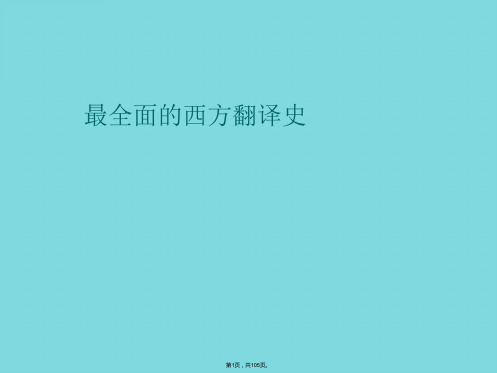
3、 各时期主要译家译论 (1)古代:
奥古斯丁(St Augstine, 345—430)
他的观点: 译者应该具备:
通晓两种语言; 要熟悉所译材料; 要有一定的校刊能力。
翻译中要注意三种风格:朴素风格,典雅风格,庄 严风格。翻译的目的只有一个,把真理传达给听众, 使听者能听懂,高兴。如果读者对译文的反应不同 于作者,就达不到教育的目的。
第6页,共105页。
2、西方历次翻译高潮
西方翻译史上的第一次高潮出现在公元前约240年。 这一时期的翻译活动主要有罗马诗人利维斯·安 德罗尼克(Lvius Andronicus 284-204B.C.) 把荷马(Homer)史诗《奥德赛》(Odyssey)译成拉 丁文诗,还有的学者把许多希腊文戏剧翻译成拉 丁文,另外,有的学者还对翻译问题进行了认真 的钻研。这一时期罗马通过翻译在文学方面大量 吸取了希腊文化。
第20页,共105页。
3、 各时期主要译家译论 (1)古代:
哲罗姆:(Jerome 340—420)
关于翻译他认为: 翻译不能始终字当句对,而应采用灵活原则。因为各种
语言在用词风格,表达习惯,句法语义等方面都存在很 大差异。
应该区别文学翻译和宗教翻译。文学翻译中,常采用 意译,宗教翻译中常采用直译。直译和意译是互补的, 在实践中加以灵活运用。在译文中很难保留原文独特 的措词风格,我也许找不到合适的字眼,如果直译的 话,译文荒唐;如果不得不作些改换调整,则有负于 原作者。
第4页,共105页。
1、西方初期的翻译活动
古代遗留下来的最著名的翻译文献,无疑要 算罗塞达碑文刻了。该碑文刻于公元前二世 纪,上面不仅刻有古埃及象形文书写的碑文, 还刻有该碑文的希腊文译文。
第5页,共105页。
翻译理论研究之四――当代西方翻译理论流派评述翻译科学派讲诉PPT课件
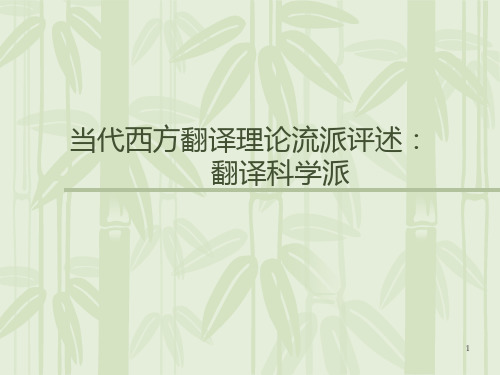
语言学理论着眼于理想的说话者——听话者。他精通这种语言而 且不受与语法无关的种种条件的影响,如记忆限度、注意分散、兴趣 转移和实际运用语言时所犯的错误。 (Chomsky,1965:3—4)
• 而且,乔姆斯基将说话主体(speaking subject)理想化,赋予其创造 性使用语言的特别能力。在理想化过程中,一些错误、意外及口误等 均被排除在乔姆斯基的模式之外,但是福科认为这些因素对于了解说 话主体及其内在性质具有和“正确的”表达同样的重要性。
• 因此,乔姆斯基的理论中有两种运动存在——通过短语结构规则从基 础到深层结构,然后通过转换规则从深层结构到表层结构。
• 乔姆斯基认为短语结构规则反映了人脑内在的无意识的活动,深层结 构决定句子内在的意义,表层结构则决定句子的发音。
6
• 许多人就乔姆斯基对人脑结构及其如何“获得”语言的看法从哲学上 提出了反对意见,批评乔姆斯基关于语言结构的证据并不是以实际存 在的语言(人们在社会环境中实际如何使用语言)为根据的,而是基 于那些只有在理想状态下才能找到的句子。
• 从历史发展来看,翻译科学派是对施莱尔马赫、洪堡等语言学和翻译观 的批判继承,但从更直接的原因看,则是对翻译培训派重实践、强调译 作品味与文学价值、注重美学经验而缺少系统化理论的反拨。
• 很显然,翻译需要更加系统化的理论来指导,而语言学的发展和所取得 的成果为翻译理论开辟了新的研究途径。Halliday的系统功能语法、 Bloomfield的结构语言学和Chomsky的转换生成语法、深层结构/表层结 构的转换规则等为翻译科学派提供了理论根据。
• 奈达简化了乔姆斯基的这一模式,只借用了后两部分来强化自己的理 论。
4
• 乔姆斯基与奈达的理论各自有着不同的发展动因与研究内容。 • 乔姆斯基的语言学探索人脑的结构,讨论语法的普遍规则及普遍词汇
《西方翻译理论史》课件

解构主义翻译理论
解构主义翻译理论强调对原作的解构和重构,认为原作的意义是不确定的,需要通过解读和诠释来理 解。
解构主义翻译理论主要包括德里达(Derrida)的解构主义思想和韦努蒂(Venuti)的异化翻译理论等 。
这些理论的核心思想是翻译过程中需要对原作进行深入解读和诠释,挖掘其潜在意义,同时注重译作的 独立性和创造性。
文艺复兴时期的翻译理论
总结词
重视人文主义与修辞学
详细描述
文艺复兴时期的翻译理论强调人文主义精神,重视原文的意义和修辞特点的传达。这一时期的翻译理论注重语言 的自然表达和风格的再现,代表人物有伊拉斯谟、约翰·德莱顿等。
03
近代翻译理论
理性主义翻译理论
总结词
强调翻译的准确性和忠实性
详细描述
理性主义翻译理论主张翻译必须准确 传达原作的意义,强调忠实性。它认 为翻译是语言的逻辑分析和推理过程 ,要求译者具备语言学、逻辑学和修 辞学等方面的知识。
总结词:重视翻译实践和经验 总结词:提倡意译 总结词:重视译文的流畅性和可读性
详细描述:经验主义翻译理论强调翻译实践和经验在翻 译过程中的重要性。它认为翻译是一种技巧,需要通过 实践不断积累经验,提高翻译水平。
详细描述:经验主义翻译理论主张意译,认为译者应该 根据目标语言的表达习惯和文化背景进行适当的调整, 以使译文更加自然流畅。
功能派
功能派强调翻译的目的性和功能性,关注译文在特定语境 中的交际功能,主张根据翻译目的选择适当的翻译策略和 技巧。
文学派
文学派强调译文的文学性和创造性,关注译文的审美价值 和艺术效果,主张译文应保持原文的艺术风格和表现手法 。
文化派
文化派强调翻译的文化交流性质,关注译文中文化信息的 传递和解释,主张译文应反映原文所处的文化背景和社会 环境。
西方翻译理论概览71页PPT
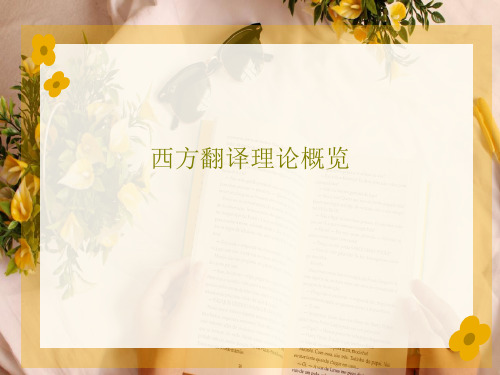
1
0
、
倚
南
窗
以
寄
傲
,
审
容
膝
之
易
安
。
6、最大的骄傲于最大的自卑都表示心灵的最软弱无力。——斯宾诺莎 7、自知之明是最难得的知识。——西班牙 8、勇气通往天堂,怯懦通往地狱。——塞内加 9、有时候读书是一种巧妙地避开思考的方法。——赫尔普斯 10、阅读一切好书如同和过去最杰出的人谈话。——笛卡儿
Thank you
文 家 。汉 族 ,东 晋 浔阳 柴桑 人 (今 江西 九江 ) 。曾 做过 几 年小 官, 后辞 官 回家 ,从 此 隐居 ,田 园生 活 是陶 渊明 诗 的主 要题 材, 相 关作 品有 《饮 酒 》 、 《 归 园 田 居 》 、 《 桃花 源 记 》 、 《 五 柳先 生 传 》 、 《 归 去来 兮 辞 》 等 。
西方翻译理论概览
6
、
露
凝
无
游
氛
,
天
高
风
景
澈
。
7、翩翩新 来燕,双双入我庐 ,先巢故尚在,相 将还旧居。
8
、
吁
嗟
身
后
名
,
于
我
若
浮
烟
。
9、 陶渊 明( 约 365年 —427年 ),字 元亮, (又 一说名 潜,字 渊明 )号五 柳先生 ,私 谥“靖 节”, 东晋 末期南 朝宋初 期诗 人、文 学家、 辞赋 家、散
《西方翻译简史》PPT课件
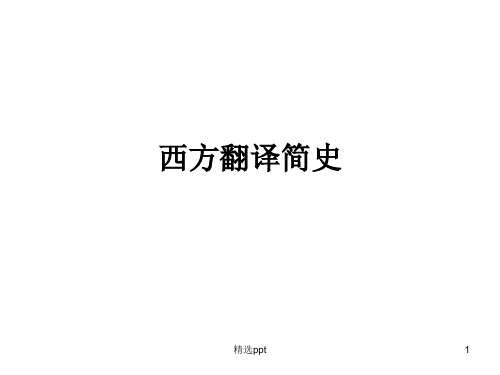
精选ppt
22
西方翻译史研究带来的启示
• 1. 在实践上不满足于现状,不停留在一个 水平上;
• 2.比较重视理论研究,不断提出新的观点和 模式;
• 3. 从西方现代译学研究的优点和缺点中得 到启示,促进我们的翻译理论研究,促进 翻译学的建设;
• 4.在翻译学的研究中应扬己之长,避人之短。
精选ppt
• 施莱尔马赫的口译和笔译、文学翻译与机械性翻译的区分; • 洪堡的语言决定世界观和可译性与不可译性的理论; • 阿诺德的"翻译荷马必须正确把握住荷马特征"的观点。
精选ppt
17
在二十世纪
• 有费道罗夫的翻译理论首先“需要从语言学方面来研究”、 翻历程,已日益显示出生命力。它是对几千年 来传统的手工翻译的挑战
精选ppt
12
二、西方译论简介
• 1. 西方最早的翻译理论家是罗马帝国时期的西塞 罗。他首次把翻译区分作为解释员和作为演说家 的翻译。
• “作为解释员”的翻译是指没有创造性的翻译;
• “作为演说家”的翻译则是指具有创造性、可与 原著媲美的翻译。
• 语言学翻译理论的缺陷是,不甚注意作品的美学 功能,忽略文艺作品的艺术再现,理论分析往往 局限于单个的词、句子或语法现象,而忽略话语 结构这一更为广泛的内容。直到最近十年来,随 着语言学和翻译理论研究的深入,这种缺陷才开 始有所修正。
精选ppt
21
• 从发展的趋势看,语言学翻译理论线已占据现代翻译理论 研究中的主导地位。理论家大都一致认为,翻译属于语言 学的研究范围,是应用语言学和对比语言学的研究范围, 是应用语言学和对比语言学的一个分支,与语义学有着密 切关系,同时又与文艺学、社会学、人类学、心理学、控 制论、信息论等多种科学有关。必须看到,不论是文艺学 翻译理论还是语言学翻译理论,它们乃是相辅相成的。翻 译既不是在所有时候都是创造性、文学性的,也不是在所 有时候都只是传递客观信息的。尤其重要的是,翻译理论 的研究必须与实践紧密结合,以指导翻译实践、揭示翻译 活动的客观的和内在的规律为其唯一的目的。否则,翻译 理论就会失去它的生命力。
当代西方翻译研究PPT课件

+ 1)前期标准:对原文版本、译文文体、风格 等的选择;
20
20世纪末译学界--女性主义批评家
+ 女性主义的观点: 1)译作与原作的地位问题。 “翻译像女人,忠实的不漂亮,漂亮的不忠
实”,不仅包含着对女性的歧视,而且也 包含着对译作的歧视 2)猛烈抨击在翻译中占据统治地位的男性 话语。(300妇女+1只公猫)
的8
+ 彼得·纽马克 补充奈达理论的不足
交际翻译(交际途径):相对意义 翻译
语义翻译:绝对意义
9
+ 卡特福特 《翻译的语言学理论》 提出翻译理论的使命就在于确定等值成分
的本质和条件。
+
10
+ 语言学派的翻译研究
+
优点: 直观、科学
6
翻译理论家及其翻译理论
罗曼·雅柯布森(Roman Jakobson)
《论翻译的语言学问题》
在符号学立场理解翻译:“两种不同语符中的 两个对等信息”重新编码的过程。
广义:语内翻译、语际翻译和符际翻译
翻译
+
狭义:语际翻译
7
+ 尤金·奈达 在交际学(语言的交际功能)理论的基础
上提出了动态对等的翻译理论 翻译等效=信息 +语言的各种功能 翻译的效果取决于花最小的功夫接受最大
12
《翻译的艺术》
书中提出了12条(实际上是六组相互矛盾的) 原则 + 1)翻译必须译出原作的文字; + 2)翻译必须译出原作的意思; + 3)译作必须译得读起来像原作; + 4)译作必须译得读起来像译作; + 5)译作必须反映原作的风格; + 6)译作必须反映译者的风格; + 7)译作必须译得像原作同时代的作品一样;
(翻译概论教学课件)第四章当代西方翻译理论

¡ 意大利美学家、文学评论家克罗齐在《美学原理》提出了完全相等于 原作表达方式的翻译不可能存在, 翻译必须靠再创造。文学翻译不 可过分自由、专业翻译不可过分拘谨的观点, 他是从美学的角度谈 翻译的。
¡ 西奥多·萨瓦里的翻译理论主要在《翻译的艺术》, 这被誉为“英语 中论述翻译的最佳之作”。他指出, 翻译是一门艺术。他把文学翻 译比作绘画, 把科技翻译比作摄影。将翻译分为完美翻译、等值翻 译、综合翻译、科技翻译四种。完美的翻译即纯粹传递信息的翻译, 等值翻译是不拘形式, 只管内容的翻译, 科技翻译的特点与等值翻 译有相似之处, 因为在科技翻译中, 内容的重要性远超过语言表达 形式的重要性。他归纳了12条准则指导翻译实践。。
第四章 当代西方翻译理论
¡ 英国翻译学家纽马克将西方研究翻译的历史划分为两大时期: 从公元前55年到20世纪上半叶属于语言学前时期, 20世纪 下半叶则属语言学时期。美国语言学家兼圣经翻译家奈达则 认为西方的翻译理论有四大流派: 语文学派、语言学派、交 际学派和社会符号学派。语言学前时期主要翻译圣经和文学 作品,翻译主要是少数人的事,这个时期的翻译理论就是奈 达所说的语文学派的理论。后三种理论流派即纽马克所说的 语言学时期的翻译理论。
¡ 奈达认为,一般意义上翻译过程包括以下几个阶段: 分析、转 移和重
组(analysis, transfer, and reconstruct),即首先 分析原作语言的息,将其剖析成结构上最简单明了的形式,在 此基础上转移,然后再
中西方翻译理论汇总PPT课件

theories (e.g. general translation theory, polysystem theory);
research methods (e.g. descriptive, empirical);
CHENLI
redefine the concepts ‘literal’ and ‘free’ in operational terms, to describe ‘meaning’ in scientific terms, and to put together systematic taxonomies of translation phenomena.
even the syntax contains a mystery – I render not word-for-word,
11
but sense for sense. (St Jerome 395 CE /1997: 25)
many modern theoreticians concur that the main problem with the writings on translation in this period was that the criteria for
容易。”
所谓“五不翻”,即五种不意译而是用音译的情形:
1、秘密故不翻。具有神秘色彩的词语应该不翻。如六字
真言“唵嘛呢叭咪吽”意为“哦!莲花里的珠宝”。不照
字面意义翻译出来,保持了佛语的神秘和庄重。
2、含多义故不翻。如梵语“薄伽梵”一词具有六种意义:
“自在、炽盛、端严、名称、吉祥、尊贵”,这些词无法
精通梵文,熟悉正确的翻译方法,不失梵文所载的义理。
5
·薄阅苍雅,粗谙篆隶,不昧此文,其备八也。
西方古典翻译家ppt课件

因为72名译者都不是希腊人,而是耶路撒冷的犹 太人,非希腊语的语言环境以及祖先的语言影响 译者,从而影响翻译质量。
4.古代翻译理论家
4.1西塞罗(Marcus Tullius Cicero,
公元前106-43):
(1)“西方翻译理论之父” (2)古罗马著名的演说家、政治家、哲学家、修辞
4.3昆体良
“不,我们可以为诗人表达的思想增加雄辩 的理论,该简略的就简略,适当遏制他的 热情。我不会让释义来限制自身,将原文 只暴露在阐释之下。我的使命是用同样的 思想和表达与原文竞争”
4.3昆体良
对“与原文竞争”提法的认识 体现出译者沙文主义的观点,与提倡异化
的观点针锋相对。 一方面强调了译者的母语及译者主体性的
4.3昆体良
Nay, we may add the vigor of oratory to the thoughts expressed by the poet, make good his omissions, and prune his diffuseness, but I would not have paraphrase restrict itself to the bare interpretation of the original: its duty is rather to rival and view the original in the expression of the same thoughts.
4.4圣·哲罗姆(St. Jerome)
(1)Introduction: 罗马神学家 翻译家、翻译理论家 主译:拉丁文《圣经》,称之为《通俗拉
丁文圣经》
4.4圣·哲罗姆(St. Jerome)
西方译论4
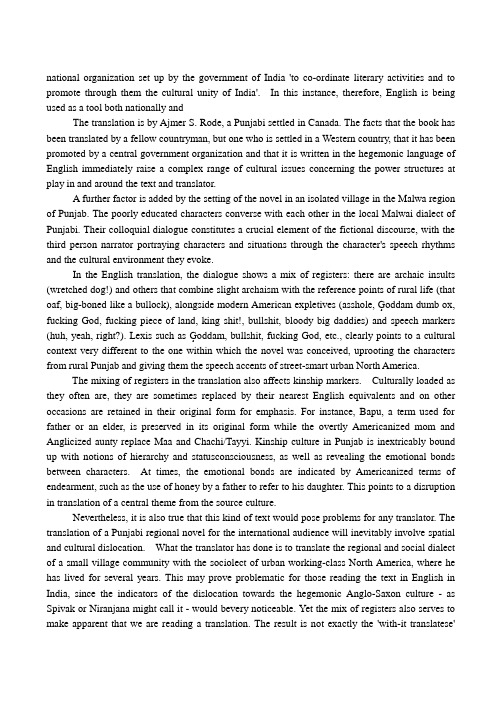
national organization set up by the government of India 'to co-ordinate literary activities and to promote through them the cultural unity of India'. In this instance, therefore, English is being used as a tool both nationally andThe translation is by Ajmer S. Rode, a Punjabi settled in Canada. The facts that the book has been translated by a fellow countryman, but one who is settled in a Western country, that it has been promoted by a central government organization and that it is written in the hegemonic language of English immediately raise a complex range of cultural issues concerning the power structures at play in and around the text and translator.A further factor is added by the setting of the novel in an isolated village in the Malwa region of Punjab. The poorly educated characters converse with each other in the local Malwai dialect of Punjabi. Their colloquial dialogue constitutes a crucial element of the fictional discourse, with the third person narrator portraying characters and situations through the character's speech rhythms and the cultural environment they evoke.In the English translation, the dialogue shows a mix of registers: there are archaic insults (wretched dog!) and others that combine slight archaism with the reference points of rural life (that oaf, big-boned like a bullock), alongside modern American expletives (asshole, Ģoddam dumb ox, fucking God, fucking piece of land, king shit!, bullshit, bloody big daddies) and speech markers (huh, yeah, right?). Lexis such as Ģoddam, bullshit, fucking God, etc., clearly points to a cultural context very different to the one within which the novel was conceived, uprooting the characters from rural Punjab and giving them the speech accents of street-smart urban North America.The mixing of registers in the translation also affects kinship markers. Culturally loaded as they often are, they are sometimes replaced by their nearest English equivalents and on other occasions are retained in their original form for emphasis. For instance, Bapu, a term used for father or an elder, is preserved in its original form while the overtly Americanized mom and Anglicized aunty replace Maa and Chachi/Tayyi. Kinship culture in Punjab is inextricably bound up with notions of hierarchy and statusconsciousness, as well as revealing the emotional bonds between characters. At times, the emotional bonds are indicated by Americanized terms of endearment, such as the use of honey by a father to refer to his daughter. This points to a disruption in translation of a central theme from the source culture.Nevertheless, it is also true that this kind of text would pose problems for any translator. The translation of a Punjabi regional novel for the international audience will inevitably involve spatial and cultural dislocation. What the translator has done is to translate the regional and social dialect of a small village community with the sociolect of urban working-class North America, where he has lived for several years. This may prove problematic for those reading the text in English in India, since the indicators of the dislocation towards the hegemonic Anglo-Saxon culture - as Spivak or Niranjana might call it - would bevery noticeable. Yet the mix of registers also serves to make apparent that we are reading a translation. The result is not exactly the 'with-it translatese'bemoaned by Spivak or the dominant Anglo-American domesticSatinig teanslations casfigated by Venuti (1995; see chapter 9); it is rather a dislocati0nary translation practice that brings into sharp relief the clash of different cultures. The characters are dislodged from their source culture, but they are also made to come alive and challenge the English-language reader. This is the kind of complex interventionist approach the translator has carried out, but he leaves himself open to the criticism that he has chosen to superimpose the sociolect of the hegemonic power.Interestingly enough, the translation of Marhi Da Deeva was followed by the translation of two other Singh novels: Addh Chanini Raat (Night of the Half-Moon, Madras: Macmillan, 1996) and Parsa (National Book Trust, 1999); these translations bring Singh to the attention of an even wider audience and are perhaps indicative of the success of the first translation.Discussion of case studyThis case stud5; which looks at the language of the TT and sees cultural implications in the choices made, has examined a case where a novel from a minority language has been translated into the hegemonic international language (English) under the auspices of a centralized national organization (the Sahitya Akademi). The language of the characters becomes mingled with that of the colonizer, and their identity - embedded in their Punjabi cultural milieu - is blurred. While postcolonial theories help to understand the power relations that operate around the translation process, it is also clear from this brief analysis of The Last Flicker that a whole range of interacting factors are at work. These include the perhaps inevitable dislocation of the source culture, the dislocation of the Punjabi translator in Canada and the location of the patronage within India itself. It would now be interesting to compare the translation strategies employed in the other novels. The aim would be to see how far this translation strategy is due to translation policy or to the way literary translators function in general. The latter is an issue that will be considered in the next chapter.SummaryThis chapter has focused on the varieties of cultural studies in translation studies. Linguistic theories of translation have been sidelined and attention has centred on translation as cultural transfer and the interface of translation with other growing disciplines within cultural studies. Those examined in this chapter have been:·section 8.1: translation as rewriting, developed from systems theories and pioneered by AndréLefevere, studying the power relations and ideologies existing in the patronage and poetics of literary and cultural systems that interface with literary translation;·section 8.2: translation and gender, with the Canadian feminist translation project described by Sherry Simon, making the feminine visible in translation;·section 8.3: translation and postcolonialism, with examples from Spivak, Niranjana and Cronincomparing the 'dislocature' of texts and translators working in former colonies of the European powers or in their languages.Niranjana in particular highlights the power relations in the translation of the colonized peoples and takes translation studies to task for its Western philosophical and ideological bias. Finally, Brazilian cannibalism, as exemplified by de Campos and Vieira, employs the metaphor of devouring the cotonizer to energize the native Brazilian tradition. The next chapter turns to examine the role of translators themselves at the cultural interface.Further readingFor an introduction to cultural studies, read Easthope (1991) or During (1999). For translation as rewriting, read additionally Lefevere (1981, 1985, 1993) and the collection of esays edited by Alvarez and Africa-Vidal (1996) for translation as a political act. Related discussion of issues of patronage follows in chapter 9. for an introduction to gender issues, read Butler (1990) and Buikeana and $melik (1995). For translation and gender, read Godard (1990)andfor the firsrsign that gay issues are beginning to enter the translation forum, read Harvey (1998/2000; see also chapter 11). For an introduction to postcolonialism, read Said (1978). In addition, for translation and postcolonialism read Cheyfitz (1991), Bhabha (1994), and Robinson (1997a), and for Brazilian cannibalism read de Campos (1992) and Vieira (1997).Discussion and research points1 Lefevere sees translation 'as potentially the most influential' (I 992a: 9) form of rewriting. Flowfar do you agree with him? Compare this with examples taken from other forms of rewriting (film adaptations, anthologization, historiography, etc.).2 Lefevere identifies three factors (the professionals, patronage and poetics) which control theliterary system, Examine how each functions in your own culture and which, if any, seems to be most important Are there other factors you would add?3 Should women writers ideally be translated by women only? What about male writers? Look atpublished translations and their prefaces to see how often this could become an issue.4 Look for examples from translations in various times and locations that reveal a gender bias.How is that 'bias' revealed? is there a pattern to these examples? How might the translator have differently?5 How far do you feel Barbara Godard is justified in 'flaunting her manipulation of the text' forfeminist purposes, or Niranjana is justified for her 'interventionist' approach?6 What research work has been carried out on postcolonialism and translation in your owncountry and language(s)? Do the results tie in with those discussed here?7 How far do you agree with Niranjana that translation studies has been overly dominated byWestern theories? If this is true, how can or should the situation be changed?8 'Co-existence implies translating the culture and (political, religious, emotional) language of theother into a language and culture that is strengthened by the presence of the other. The alternative to translation is the muteness of fear' (Cronin 1996: 200). How far does misstatement hold for the linguistic policies of your own country? What examples have you come across of translation involving a power difference between the two languages and cultures?9 Translating the foreign: the (in)visibility of translationKey textsBerman, A. (1984,/92) L'épreuve de I'étranger: Culture et traduction dans I'Allemagne romantique, Paris: Éditions Gallimard; translated (1992) by S. Heyvaert as The Experienceof the Foreign: Culture and Translation in Romantic Germany, Albany: State University ofNew York.Berman, A. (1985b/2000) 'Translation and the trials of the foreign', translated by L. Venuti, in L. Venuti (ed.) (2000), pp. 284-97, (Originally published as 'La traduction comme epreuve de I'éranger', Texte ( 1985): 67-81 ).Felstiner, J. (1980) Translating Neruda: The Way to Macchu Picchu, Stanford, CA: Stanford University Press.Levine, S. (1991) The Subversive Scribe: Translating Lat/n American Fiction, St Paul, MN: Graywolf Press.Venuti, L. (ed.) (1992) Rethinking Translation: Discourse, Subjectivity, Ideology, London and New York: Routledge.Venuti, L. (1995) The Translator's Invisibility:A History of Translation, London and New York:Routledge.Venuti, L. (1998) The Scandals of Translation: Towards an Ethics of Difference, London and New York: Routledge.9.0 IntroductionChapter 8 examined varieties of cultural studies that have focused on translation. In this chapter, we concentrate on other research that deals with cultural difference and with the interface between the source culture and the foreign, linking ideology and dominant discourse to translation strategies.Section 9.1 focuses on- key areas- of--the-influential work of Lawrence Venuti, notably the 'invisibility' of translation and the translator in Anglo-American culture (section 9.1.1) and the 'domesticating' and 'foreignizing' translation strategies which are avail able to the tramslator (section 9,1.2). Section 9.1.3 considers work by Antoine Berman that follows a similar line, Berman's 'negative analytic' attacking the homogenization of the translation of literary prose.The remainder of the chapter considers other related areas and players in the translation process. Thus, in section 9.2 a description is given of what practising literary translators say about their practices, in order to see if their own view of their work tallies with Venuti's and Berman's theories. Section 9.3 deals with crucial aspects of the powerful publishing industry and section 9.4 discusses criticisms of Venuti. Finally, section 9.5 examines the reception of translations, notably the reviewing process, and what this reveals about cultural attitudes to translation in general. Following this, the case study illustrates one method of investigating these ideas by analyzing the reviews of a translated text.9. 1 Venuti: the cultural and political agenda of translationLike the other cultural theorists discussed in chapter 8, Venuti insists that the scope of translation studies needs to be broadened to take account of the value-driven nature of the sociocultural framework. Thus he contests Toury's 'scientific' descriptive model with its aim of producing 'value-free' norms and laws of translation (see chapter 7):Toury's method ... must still turn to cultural theory in order to assess the significance of the data, to analyze the norms. Norms may be in the first instance linguistic or literary,; but they will also include a diverse range of domestic values, beliefs, and social representations which carry ideological force in serving the interests of specific groups. And they are always housed in the social institutions where translations are produced and enlisted in cultural and political agendas.(Venuti 1998: 29)In addition to governments and other politically motivated institutions, which may decide to censor or promote certain works (compare Lefevere's discussion of control factors in section 8.1), thegroups and social institutions to which Venuti refers would include the various players in the publishing industry as a whole. Above all, these would be the publishers and editors who choose the works and commission the translations, pay the translators and often dictate the translation method. They also include the literary agents, marketing and sales teams and reviewers. The reviewers' comments indicate and to some extent determine how translations are read and received in the target culture. Each of these players has a particular position and role within the dominant cultural and political agendas of their time and place. The translators themselves are part of that culture, which they can either accept or rebel against.9.1.1 Venuti and the 'invisibility' of the translatorInvisibility is a term used by Venuti (1995: 1) 'to describe the translator's situation and activity in contemporary Anglo-American culture'. Venuti sees this invisibility as typically being produced:1 by the way translators themselves tend to translate 'fluently' into English, to produce anidiomatic and 'readable' TT, thus creating an 'illusion of transparency';2 by the way the translated texts are typically read in the target culture:A translated text, whether prose or poetry, fiction or non-fiction, is judged acceptable by mostpublishers, reviewers and readers when it reads fluently, when the absence of any linguistic or stylistic peculiarities makes it seem transparent, giving the appearance that it reflects the foreign writer's personality or intention or the essential meaning of the foreign text - the appearance, in other words, that the translation is not in fact a translation, but the 'original'.(Venuti 1995: 1)Venuti (1998:31) sees the most important factor for this as being 'the prevailing conception of authorship'. Translation is seen as derivative and of secondary quality and importance. Thus, the English practice since Dryden has been to conceal the act of translation so that, even now, 'translations are rarely considered a form of literary scholarship' (Venuti 1998: 32).9. 1.2 Domestication and foreignizationVenuti (1995: 19-20) discusses invisibility hand in hand with two types of translating strategy: domestication and foreignization. These strategies concern both the choice 'of text to translate and the translation method. Their roots are traced back by Venuti to Schleiermacher and his 1813 essay 'Űber die verschiedenen Methoden des Űbersetzens' (see chapter 2). Venuti (1995: 21) sees domesticationas dominating Anglo-American translation culture. Just as the postc01onialists are alert to the cultural effects of the differential in power relations between colony and ex-colony, so Venuti (1995: 20) bemoans the phebinebib if domestication.stication since it involves 'anethnocentric reduction of the foreign text to [Anglo-American] target-language cultural values'. This entails teanstating in a transparent, fluent, 'invisible' style-in order to mibunuze the foreugbs of the TT. Venuti allies it with Schkeuermacher's descriprion that 'leaves the reader in peace, as much as possible, and moves the author towards him' (Schleiermacher 1813/1992: 41-2;see chapter 2 of this book). Domestication further covers adheyence to domestic literary canons by carefully selecting the texts that are likely to lend themselves to such a translation strategy (Venuti 1997: 241).Foreignization, on the other hand, 'entails choosing a foreign text and developing a translation method along lines which are excluded by dominant cultural values in the target language' (Venuti 1997: 242). It is the preferred choice of Schleiermacher, whose description is of a translation strategy where 'the translator leaves the writer alone, as much as possible and moves the reader towards the writer' (Schleiermacher 1813/1992: 42). Venuti (1995: 20) considers the foreignizing method to be 'an ethnodeviant pressure on [target-language cultural] values to register the linguistic and cultural difference of the foreign text, sending the reader abroad'. It is 'highly desirable', he says, in an effort 'to restrain the ethnocentric violence of translation'. In other words, the foreignizing method can restrain the 'violently' domesticating cultural values of the English-language world. The foreignizing method of translating, a strategy Venuti also terms 'resistancy' (1995: 305-6), is a non-fluent or estranging translation style designed to make visible the presence of the translator by highlighting the foreign identity of the ST and protecting it from the ideological dominance of the target culture.In his later book The Scandals of Translation (1998), Venuti continues to insist on foreignizing or, as he also calls it, 'minoritizing' translation, to cultivate a varied and 'heterogeneous discourse' (Venuti 1998:11). One of the examples he gives of a minoritizing project is his own translation of works by' the nineteenth-century Italian Tarchetti (pp. 13-20). The choice of works to translate is minoriti:ing since Tarchetti was a minor nineteenth-century Italian writer, a Milanese bohemian who further challenged the literary establishment by using the standard Tuscan dialect to write experimental and Gothic novels and by challenging the moral and political values of the day. As far as the language is concerned, the minoritizing or foreignizing method of Venuti's translation comes through in the deliberate inclusion of foreignizing elements, such as modern American slang, in a bid to make the translator 'visible' and to make the readers realize they are reading a translation of a work from a foreign culture. Venuti gives the extract shown in box9.1 as an example of what he means by this approach.Among the elements of this extract which Venuti considers to be distinctive of foreignization are the close adherence to the ST structure and syntax (e.g. the adjunct positions in the first sentence), the caiques soggiorno as sojourn, indurlo as induce him and the archaic structure nor could I ever. In other passages (see Venuti 1998: 16-17), he juxtaposes both archaisms (e.g. scapegrace) and modern colloquialisms (e.g. con artist, funk), and uses British spellings (e.g.demeanour, offence) to jar the reader with a 'heterogeneous discourse'. "Venuti is happy't0 note (t998; 15) that some of the reviews of the translation were appreciative of his 'visible' translating strategy. However, he also adds (pp. 18-19) that some of the reviews attacked the translation for not being what, in Venuti's terms, would be domestication.Box 9.1Although Venuti advocates foreigni'_ing translation, he is also aware (1995: 29) of some of its contradictions, namely that it is a subjective and relative term that still involves some domestication because it translates an ST for a target culture and depends on dominant target-culture values to become visible when it departs from them. However, Venuti defends foreignizing translations. They 'are equally partial [as are domesticating translations] in their interpretation of the foreign text, but they do tend to flaunt their partiality instead of concealing it' (1995: 34). Importantld; it should also be pointed out at this point that domestication and foreignization are considered bi' Venuti (1999), in the introduction to the Italian translation of TheTranslator's Invisibility, to be 'heuristic concepts ... designed to promote thinking and research' rather than binary opposites: 'They possess a contingent variabilit3, such that they can only be defined in the specific cultural situation in which a translation is made and works its effects.' This, according to Vcnuti, means that the terms may change meaning across time and location. What does not change, however, is that domestication and foreignization deal with 'the question of how much a translation assimilates a foreign text to the translating language and culture, and how much it rather 'signals the differences of that text'. This is a question which had already attracted the attention of the noted French theorist, the late Antoine Berman.9.1.3 Antoine Berman: the 'negative analytic' of translationAntoine Berman's major theoretical work - L'épreuvede l'étranger: Culture, traduction dans l 'Atlemagne romantique (1984), translated into English as The Experience of the Eoreign: Culture and Translation in Romantic Ģermany (1992)- precedes and influences Venuti, who himself has recently produced an English translation of an important article by Berman. This article, 'La traduction comme épreuve de l'étranger' (1985), is entitled 'Translation and the trials of the foreign' in English (in Venuti 2000). The change from experience in the title of the book to trials in the article is perhaps indicative of Venuti' desire to challenge the reader by highlighting the challenge and trials that translation represents to the ST. Berman (2000: 284) describes it as an épreuve ('trial') in two senses:1 a trial for the target culture in experiencing the strangeness of the foreign text and word;2 a trial for the foreign text in being uprooted from its original language context.Berman deplores the general tendency to negate the foreign in translation by the translation strategy of 'naturalization', which would equate with V enuti's later 'domestication'. 'The properly ethical aim of the translatin: act', says Berman (p. 285), is 'receiving the foreign as foreign', which would seem to have influenced Venuti's 'foreignizing' translation strategy, However, Berman considers (p. 286) that there is generally a 'system of textual deformation' in TTs that prevents the foreign coming through. His examination of the forms of deformation is termed 'negative analytic': The negative analytic is primarily concerned with ethnocentric, annexationist translations and hypertextual translations (pastiche, imitation, adaptation, free writing), where the play of deforming forces is freely exercised.(Berman 1985b/2000:286 Berman, who translated Latin American fiction and German philosophy, sees every translator as being inevitably and inherently exposed to these ethnocentric forces, which determine the 'desire to translate' as well as the form of the TT. He feels (p. 286) that it is only by psychoanalytic analysis of the translator's work, and by making the translator aware of these forces that suchtendencies can be neutralized. His main attention is centred on the translation of fiction:The principal problem of translating the novel is to respect its shapeless polylogic and avoid an arbitrary homogenization.(Berman 1985b/2000:287)By this, Berman is referring to the linguistic variety and creativity of the novel and the way translation tends to reduce variation. He identifies twelve 'deforming tendencies' (p. 288):1 Rationalization: This mainly affects syntactic structures including punctuation and sentencestructure and order. Berman also refers to the abstractness of rationalization, the translation of verbs by noun forms and the tendency to generalization.2 Clarification: This includes explicitation, which 'aims to render "clear" what does not wish to beclear in the original' (p. 289).3 Expansion: Like other theorists (for example, Vinay and Darbelnet; see chapter 4), Bermansays that TTs tend to be longer than STs. This is due to 'empty' explicitation that unshapes its rhythm, to 'overtranslation' and to 'flattening'. These additions only serve to reduce the clarity of the work's 'voice'.4 Ennoblement: This refers to the tendency on the part of certain translators to 'improve' on theoriginal by rewriting it in a more elegant style. The result, according to Berman (p. 291), is an annihilation of the oral rhetoric and formless polylogic of the ST. Equally destructive is a TT that is too 'popular' in its use of colloquialisms.5 Qualitative impoverishment: This is the replacement of words and expressions with TTequivalents 'that lack their sonorous richness or, correspondingly, their signifying or "iconic"features' (p. 291). By iconic or iconicity, Berman means terms whose form and sound are in some way associated with their sense. An example he gives is the word butterfly and its corresponding terms in other languages.6 Quantitative impoverishment: This is loss of lexical variation in translation. Berman gives theexample of a Spanish ST that uses three different synonyms for face (semblante, rostro and tara); rendering them all as face would involve loss.7 The destruction of rhythms: Although more common in poetry, rhythm is still important to thenovel and can be 'destroyed' by deformation of word order and punctuation.8 The destruction of underlying networks of signification: The translator needs to be aware of thenetwork of words that is formed throughout the text. Individually, these words may not be significant, but they add an underlying uniformity and sense to the text. Examples are augmentative suffixes in a Latin American text (jaul6n, port6n, etc.).9 The destruction of linguistic patternings: While the ST may be systematic in its sentenceconstructions and patternings, translation tends to be 'asystematic' (p. 293). The translator likely adopts a range of techniques, such as rationalization, clarification and expansion which, although making the TT linguistically more homogenous, also render it more 'incoherent'because the systematicity of the original is destroyed.10 The destruction of vernacular networks or their exoticization: This relates especially to localspeech and language patterns which play an important role in establishing the setting of a novel. There is severe loss if these are erased, yet the traditional solution of exoticizing some of these terms by, for example, the use of italics, isolates them from the co-text. Alternatively, seeking a TL vernacular or slang is a ridiculous exoticization of the foreign (compare the case study from Punjabi in chapter 8).11 The destruction of expressions and idioms: Berman considers the replacing of an idiom orproverb by its TL 'equivalent' to be an 'ethnocentrism': 'to play with "equivalence" is to attack the discourse of the foreign work', he says (p. 295). Thus, an English expression from Conrad containing the name of the well-known insane asylum Bedlam, should not be translated by 'Charenton', a French insane asylum, since this would result in a TT that produces a network of French cultural references.12 The effacement of the superimposition of languages: By this, Berman means the waytranslation tends to erase traces of different forms of language that co-exist in the ST. These may be the mix of peninsular and Latin American Spanishes in the work of Valle-Inclán, the proliferation of language influences in Joyce's Finnegan's Wake, different sociolects and idiolects, and so on. Berman (p. 296) considers this to be the 'central problem' in the translation of novels.Counterbalancing the 'universals' of this negative analytic is Berman's 'positive analytic' (pp. 286, 296-7), his proposal for the type of translation required to render the foreign in the TT. This he calls 'literal translation':Here 'literal' means: attached to the letter (of works). Labor on the letter in translation, on the one hand, restores the particular signifying process of works (which is more than their meaning) and, on the other hand, transforms the translating language.(Berman 1985b/2000:297)Berman's term is markedly different and more specific compared to the conventional use of literal translation discussed in chapter 2; his use of literal and letter and his reference to the 'signifying process' point to a Saussurean perspective and to a positive transformation of the TL. The term literal is also discussed by Venuti (1995: 146-7), who construes the letter as 'the range of signifying possibilities in the TL'.Berman's work is important in linking philosophical ideas to translation strategies with many examples drawn from existing translations. His discussion of the ethics of translation as witnessed in linguistic 'deformation' of TTs is of especial relevance and a notable counterpoint to earlier writing on literary translation. Yet, despite Berman's concern for the foreign in translation, it is Venuti's work that has attracted more attention and aggressive reaction (see section 9.4). The。
西方翻译理论PPT课件
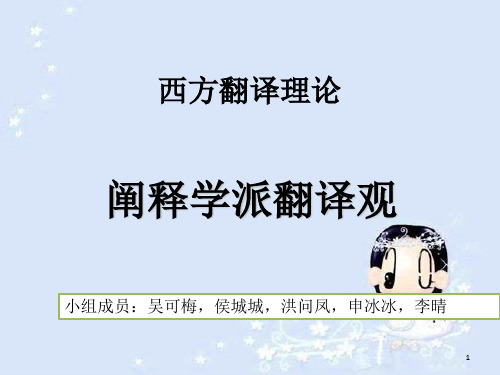
2.中世纪:对《圣经》等宗教经典进行注释、说 明,向人们澄清上帝的意图。
3.文艺复兴和宗教改革时期: 不再拘泥于宗教经典,而是扩大到对 古代文化经典的阐释。
4
二.阐释学派一步一步发展成为一门学科
施莱尔马赫:是阐释学成为一种普通的方法论。 狄尔泰:拓展了释义学的领域并将它引入哲学。 海德格尔:本体论转折。 伽达默尔:哲学阐释学体系。
演讲人:XXXXXX 时 间:XX年XX月XX日
14
7
四、发展了阐释学的方法,在原有的理解文本字面涵义 的语法解释法基础上,又提出了理解作者或谈话者内心 世界的心理解释法,并把前者看做辅助后者的方法;
五、深化了对解释过程的理解,认为在解释学循环中不 是纯理性的,其中直觉、体悟或灵感的东西在起作用;
六、强调必须比作者理解他自己更理解作者,因为作者 对自己无意识的思想层面没有领会,需要阐释者把它揭 示出来。
伽达默尔:德国当代哲学家、美学家,现代哲学阐释学和 解释学美学的创始人和主要代表之一。主要著作《真理与 方法》。
伽达默尔在哲学阐释学中指出理解的普遍性、历史性和创 造性;
他提出了“合法的偏见”、“效果历史”、 “视域融合”的精辟理论,解释了重译、 误译的许多翻译现象。
10
四.斯坦纳与阐释学
于1975年出版的《通天塔之后:语言与翻译面面观》(After Babel : Aspects of Language and Translation) 被视作当代西方翻译 研究的里程碑式著作
12
结束语
当你尽了自己的最大努力时,失败也是伟大的, 所以不要放弃,坚持就是正确的。
When You Do Your Best, Failure Is Great, So Don'T Give Up, Stick To The End
西方译论Chapter 4

4.1 Vinay and Delbelnet‟s Model
2
Calque 仿造
SL expression or
structure is transferred in a literal translation.
e.g. 英语中Compliments of the season 译为法语 Compliments de la saison. 中文的 好好学习,天天向上 译为Good good study, day day up.
4.1.4
An important parameter(参数)
1. Servitude:
obligatory transpositions
and modulations due to
a difference between
the two language systems.
Second self He is a bad drunk.
白色咖啡 ×
第二个自己 × 他是个坏酒鬼
加了牛奶的咖啡√
心腹朋友√ 他不善饮酒。 √
。×
4.1 Vinay and Delbelnet‟s Model
3
Literal translation直译
Word-for-word translation
become fully integrated into TL, although sometimes with some semantic change, which can turn them into false friends. (e.g. To pull one‟s leg 愚弄某人 ,
Second self心腹朋友).
To eat one’s words
中西方翻译简史和西方翻译理论PPT课件( 33页)
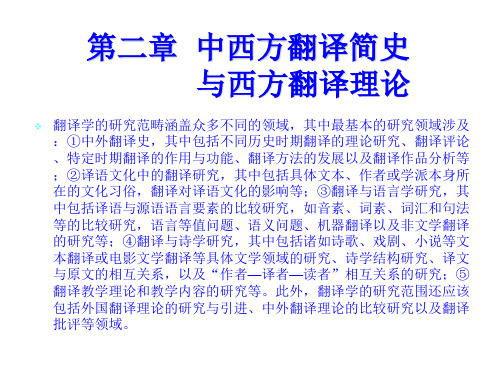
第三节 西方翻译理论简介
中外翻译学者都曾对西方翻译理论进行过流派划分,以期把握其发展 的内在规律。一种方法是将西方翻译理论划分为四个基本学派:即语 文学派、语言学派、交际理论学派和社会符号学派。语文学派主要关 注原文的文学特征,重原文而忽略读者,注重“语义结构、内容选择 和组织的方式”,“详细分析修辞手法,权衡和比较修辞价值”。该 学派提出了“到底是让信息适应人,还是让人适应信息”的问题,并 针对直译和意译展开辩论。语言学派认为翻译是比较语言学的一个分 支,强调意义的构成特征以及源语和译语在语言结构方面的差别,强 调两者之间的对应关系(但主要是在表面层次的),并试图制定对等转 换的规则,其代表人物为英国翻译理论家卡特福德。交际理论学派力 图从信息源、信息和信息接受者、媒体等方面研究翻译问题,认为应 该突出信息接受者的作用,强调信息交流而非语言对等,其代表人物 包括德国莱比希学派的卡德和纽伯特等。社会符号学派以皮尔斯的符 号学为理论基石,强调“语言的功能以及这些功能与其他符码的关系” 以及符号、所指和解释者三者之间的互动关系,要求译者关注文字以 外的更多信息,认为许多社会文化因素可能影响信息的传递,所以译 者应该注意文字所存在的社会文化环境。美国著名翻译理论家奈达是 该学派的重要代表人物。
传统翻译学阶段成就了众多著名的翻译理论家,其中英国翻译理论家 亚历山大·佛雷泽·泰特勒(1747—1814年)的学术地位可谓举足轻重。 他的翻译理论专著《论翻译的原则》(Essay on the Principles of Translation) 在英国和西方翻译理论史上具有里程碑式的意义。泰特 勒在该书中首先对“优秀的翻译”作出了定义,然后提出了翻译的三大 原则:即复写原作思想,风格手法与原作同一,具备原作的通顺。这 对后来有关“忠实”和“自由”(即“直译”和“意译”)的讨论产生了很大的影 响。
当代西方翻译理论PPT文档33页

1、不要轻言放弃,否则对不起自己。
2、要冒一次险!整个生命就是一场冒险。走得最远的人,常是愿意 去做,并愿意去冒险的人。“稳妥”之船,从未能从岸边走远。-戴尔.卡耐基。
梦 境
3、人生就像一杯没有加糖的咖啡,喝起来是苦涩的,回味起来却有 久久不会退去的余香。
当代西方翻译理论4、守业的最好办法就是不断的发展。 5、当爱不能完美,我宁愿选择无悔,不管来生多么美丽,我不愿失 去今生对你的记忆,我不求天长地久的美景,我只要生生世世的轮 回里有你。
- 1、下载文档前请自行甄别文档内容的完整性,平台不提供额外的编辑、内容补充、找答案等附加服务。
- 2、"仅部分预览"的文档,不可在线预览部分如存在完整性等问题,可反馈申请退款(可完整预览的文档不适用该条件!)。
- 3、如文档侵犯您的权益,请联系客服反馈,我们会尽快为您处理(人工客服工作时间:9:00-18:30)。
(A comparative stylistic analysis of French and English)
Different translation strategies and 'procedures'
wide impact:French-German translantion
English-Spanish translation p.56
西方译论Chapter 4
OUTLINE
4.1 Vinay and Darbelnet's model 4.2 Catford and translation ‘shifts’
4.4 Van Leuven-Zwart's comparative-descriptive
model of translation shifts
4.1 Vinay and Delbelnet’s Model Borrowing 借用
Used to fill a semantic gap in the TL(e.g.俄语rouble卢布);
1
The SL word is transferred directly to the TL.
Sometimes employed to add local colour (e.g.阿马尼亚克酒,一种法国白兰地); 麻将(mahjong), 豆腐(tofu), 功夫(kungfu)
Part 1
《法英比较文体学:翻译方法论》
综观全书, 维内和达贝尔内虽然未提出翻译转移这 个概念, 但他们对翻译过程的详细划分、对原文与
译文差异的详尽比较与后来翻译转移研究的精神如
出一辙。在这种意义上, 把他们称为翻译转移研究
的早期代表并不为过。
4.1 Vinay and Delbelnet’s Model
(A special kind
of borrowing)
4.1 Vinay and Delbelnet’s Model
1&2
2 Strategies & 7 Procedures
Vinay and Darbelnet note that
both borrowings and calques often
4.1 Vinay and Delbelnet’s Model
2
Calque 仿造
SL expression or
structure is transferred in a literal translation.
e.g. 英语中Compliments of the season 译为法语 Compliments de la saison. 中文的 好好学习,天天向上 译为Good good study, day day up.
become fully integrated into TL, although sometimes with some semantic change, which can turn them into false friends. (e.g. To pull one’s leg 愚弄某人 ,
Second self心腹朋友).
Part 1
2 Strategies翻译方法 间接翻译:
直接翻译:
根据源语和目标语中相同的
由于源语和目标语在
“结构上和元语言上的差异”, 译者只有在改变目标 语的句法顺序或是词汇 的条件下才能移植源语特
范畴或概念, “把源语信息
中的每一个要素都转移至 目标语中”;
定文体效果的诸种翻译方法
4.1 Vinay and Delbelnet’s Model
To eat one’s words
To keep an eye on To pull one’s leg
食言 ×
睁一只眼闭一只眼 × 拖后腿 ×
收回前言,认错道歉√
照看,密切关注√ 愚弄某人√ 经常吵架√
To lead a cat-and dog life 过着猫狗般的生活×
4.1 Translation Shifts 翻译转移
Small linguistic changes occurring in
translation of ST to TT.
译自源文本的目标文本中出现的细微的语言变化
4.1 Vinay and Delbelnet’s Model
维内和达贝尔内 Stylistique comparee du francais et de l’anglais (《法英比较文体学:翻译方法论》1958) Differences between the languages
4.1 Vinay and Delbelnet’s Model
1&2
False friends are pairs of words in two languages (or letters in two s) that look and/or sound simil ar, but differ in meaning.
4.1 Vinay and Darbelnet's model
4.1.1 Two Strategies 4.1.2 Seven procedures
4.1.3 The seven categories operate on three levels 4.1.4 A further important parameter
4.1 Vinay and Delbelnet’s Model
Part 1
《法英比较文体学:翻译方法论》
该书从词汇、句法结构、信息这三个平面对 法语和英语作了全面、细致的比较和分析, 详尽地区分了翻译方法和翻译过程, 对西方翻译教学与研究有相当深远的影响。
4.1 Vinay and Delbelnet’s Model
Part 1
7 Procedures翻译过程
Direct translation
(直接翻译Literal): Borrowing Calque
Literal translation
Oblique translation (间接翻译Free): Transposition Modulation Equivalence Adaptation
